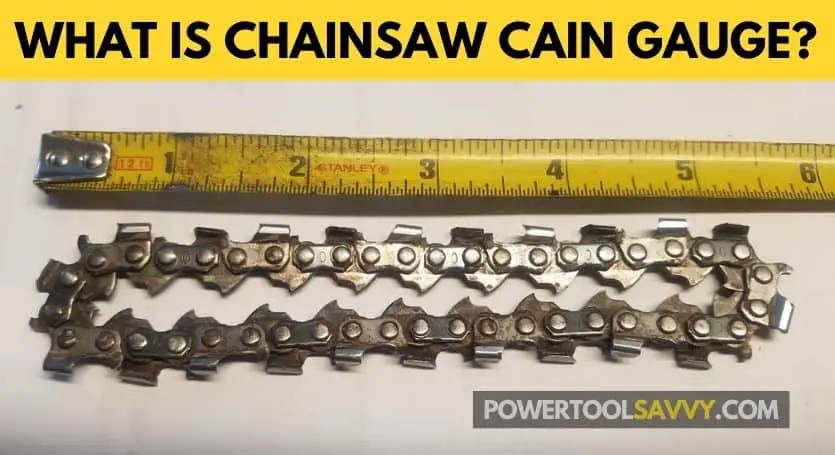
Ah, chain gauge – a widely used term in the chainsaw world!
But have you ever wondered what it actually means?
Don’t WORRY!
I have over 20 years of chainsawing experience and in this article, I’m going to break it down for you.
Let’s get started!
Table of Contents
ToggleWhat is Chainsaw Chain Gauge?
The chain gauge refers to the thickness of the drive links (the part of the chain that fits into the guide bar). It’s measured in inches and there’re mainly 4 different chain gauges available: .043”, .050”, .058”, and .063″.
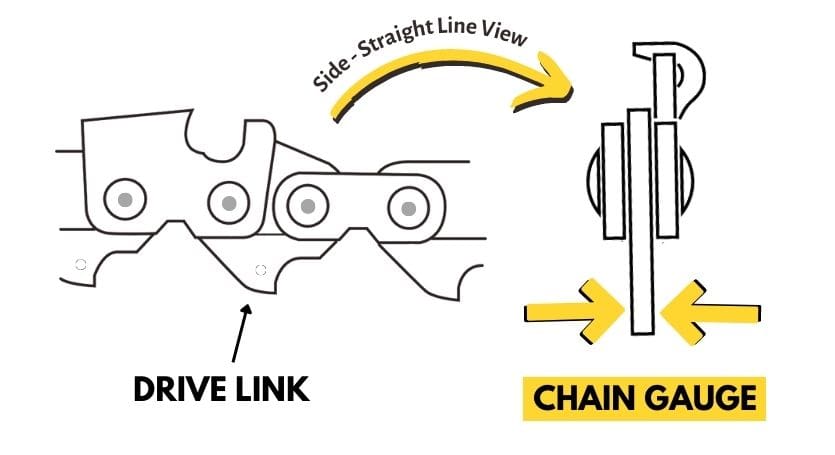
In other words, it’s the width of the groove of your guide bar where the chain runs.
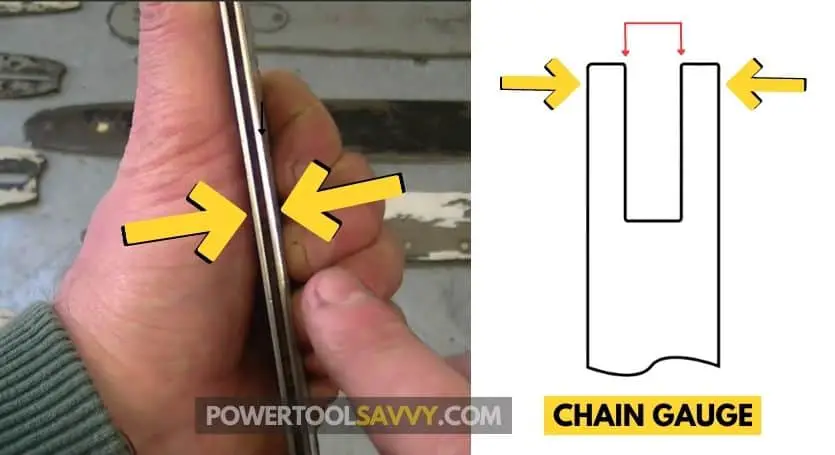
The HIGHER the number, the thicker and stronger the drive links are. And as a result, the chain will last longer and be less likely to produce crooked cuts.
However, this also means that chains with a higher gauge will be heavier. Plus, it’ll require significantly more horsepower to drive them around the bar.
(Trade-offs, man… trade-offs!)
That’s why, small or pruner saws like the Stihl MS 170 and MS 250, come with a .043” gauge chain.
On the other end, higher cc saws like the MS 462 and MS 661 use a 0.058” or .063” gauge.
How to Determine the Gauge of a Chainsaw Chain?
Now that you know what a chainsaw chain gauge is, you might be wondering: how do I know the gauge of my current chain?
Here are 4 different ways to figure it out: 👇
1. Check the Writings on Your Guide Bar
If it’s a STOCK chain (the one that came with your saw), then the chain gauge might be written on your guide bar.
For example, here’s a guide bar that takes a .058″ gauge chain: 👇
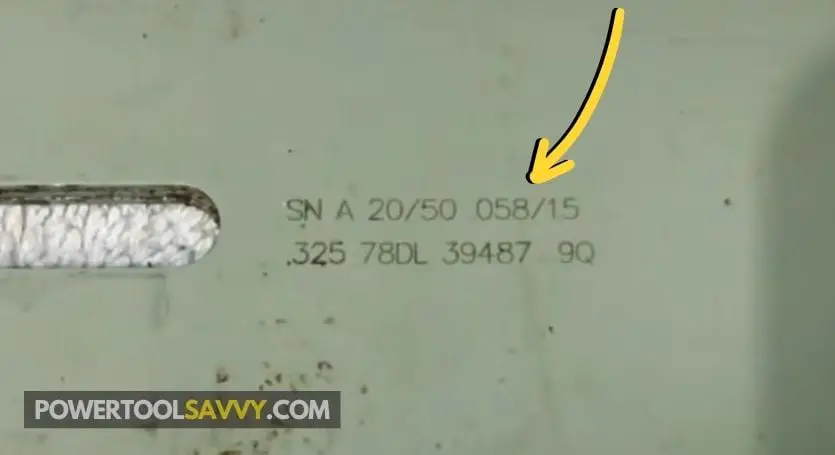
✍️ Note: Some manufacturers mention the gauge in millimeters, instead of inches.
For example, here’s a bar that says 1.6 (mm), which is the same as .063″ (in): 👇
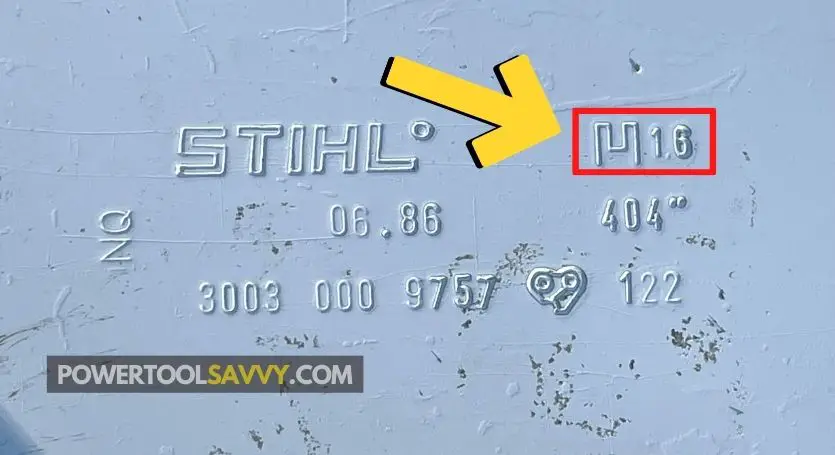
So, don’t get confused!
Refer to this table to convert the gauge from millimeters to inches: 👇
| Inches | Millimeter (mm) |
|---|---|
| .043" | 1.1 mm |
| .050" | 1.3 mm |
| .058" | 1.5 mm |
| .063" | 1.6 mm |
2. Check the User Manual
Yeah, that’s RIGHT!
Not every bar has the chain gauge written on it.
In that case, the BEST way to determine the gauge is by checking the manual.
Open it up and GO to the “Specifications” or “Technical Data” section. You should find the gauge listed there.
For example, here’s a Husqvarna 120 Mark II saw, which takes a 1.3mm/0.050″ gauge chain: 👇
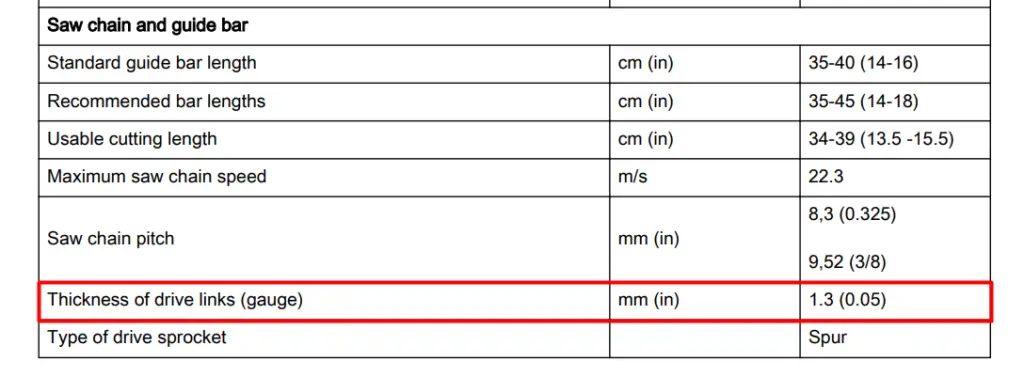
3. Check the Chain Packaging
If you’ve purchased a replacement chain, the gauge should be printed/stamped on the packaging.
I hope you didn’t throw away the box yet!
Here’s an example of what a 0.050″ gauge chain package looks like: 👇
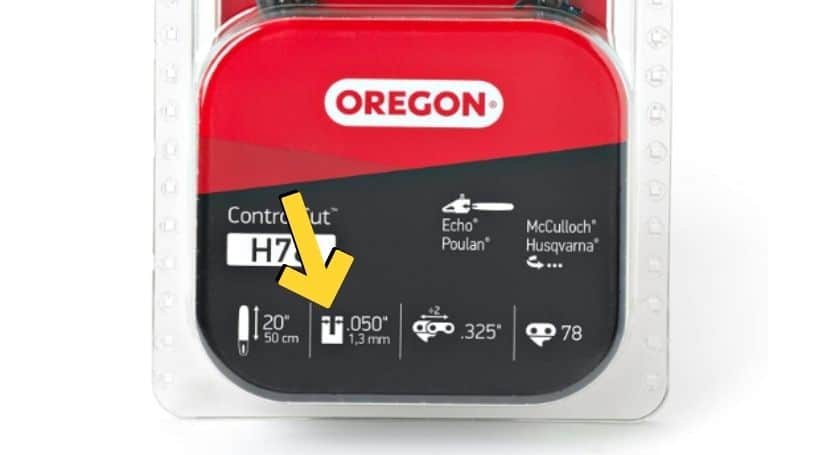
4. Reading the Number Stamped on the Drive Links
Have you ever noticed a small number stamped on each drive link? 🤔
Well, that’s not a RANDOM number. It actually tells you the gauge and pitch of your chain. (Read this article to learn about 👉 chainsaw chain pitch!)
Depending on your chain brand, model, and type, you may find different variations of numbers stamped on the drive links.
Here’s a chart that includes a few common stamped numbers on various branded chains and their corresponding gauge size: 👇
| Chain Pitch | Chain Gauge | Woodland | Carlton | Husqvarna | Oregon | Stihl | Windsor | McCulloch | Dolmar |
|---|---|---|---|---|---|---|---|---|---|
| 1/4" | .043" (1.1mm) | 71SC | - | - | - | 71 | - | - | - |
| 1/4" | .050" (1.3mm) | 13SC, 10SC | E1MC | H00 | 25 | 13 | 50K | 13RM | - |
| 3/4" | .122" (3.0mm) | 71(H) | G7S | - | 11 | - | 3HC | - | - |
| 3/8" | .050" (1.3mm) | 30SC(S), 30RC(S), 30RP | A1EP, A1LM | H51, H47, H46, H80, H475, H82 | 72 | 33 | 50A | PM370, SPR370, M370 | 100, 92 |
| 3/8" | .058" (1.5mm) | 38RC, 38RP | A2EP, A2LM | H54, H48, H42, H81, H48S | 73 | 35 | 58 | SPR378 | 99 |
| 3/8" | .063" (1.6mm) | 33RC, 36RCS, 33RP | A3EP, A3LM | H50, H45, H83 | 75 | 36 | 63 | PM373, SPR373 | 110 |
| .325" | .043" (1.1mm) | - | - | - | 80 | - | - | - | - |
| .325" | .050" (1.3mm) | 20NK, 20SC, 20RC, 20RCS | K1NK, K1CL, K1C | H30, H22, H23, H27, H78 | 95, 20, 33 | 23 | 50J | PM320, SPR320 | 82 |
| .325" | .058" (1.5mm) | 28RC | K2C, K2L | H25, H21 | 21, 34 | 25 | 58J | SPR328 | 083, 686 |
| .325" | .063" (1.6mm) | 23RC, 23SC | K3C, K3L | H26 | 22, 35 | 26 | 63J | - | - |
| .404" | .063" (1.6mm) | 43RC(S), 43RP, 46RCS | B3EP, B3LM, B3H, B3M | H64, H57, H65 | 27, 68, 16 | 46 | 63B, HC | PM403, SPR403 | 103, 108 |
| .404" | .080" (2.0mm) | 48H(X) | B5M | - | 19, 18 | 40 | 2HC | - | - |
Now all you need to do is to find the number that’s stamped on your drive link, and then compare it with this chart.
For example, here’s a Carlton chain with an “A1” stamped on the drive links: 👇
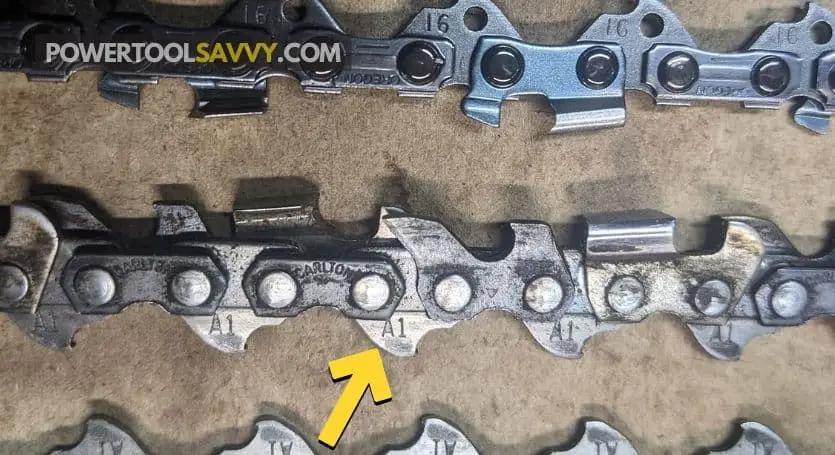
And if I look for “A1” in the chart, I see that it corresponds to a .050″ gauge.
Ta-da! 🔥
5. Measure It Yourself
If all else FAILS, you can always measure it yourself!
Normal tape or ruler won’t work here. You’ll need a vernier caliper to accurately measure the width of the groove.
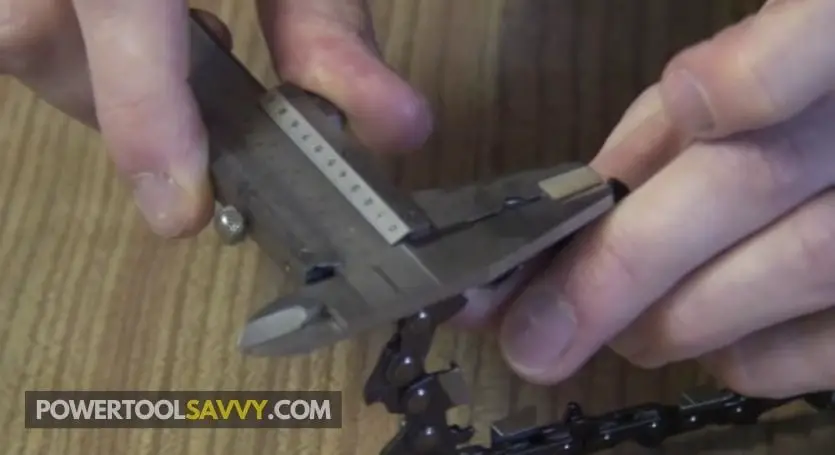
If that’s not possible for you, you can get one of these chainsaw bar and chain measuring tools. (They’re not super expensive!)

I got mine from Amazon and it’s quite helpful.
✍️ Note: It’s HARD to measure the gauge of older chains accurately due to the wear and tear.
Can I use a Different Gauge Chain on My Chainsaw?
You can use a different gauge chain on your chainsaw but you need to replace the bar with one that is compatible with the new gauge.
For example, if you’re using a .050″ gauge chain, and you want to switch to a .058″ gauge, then you’ll need to buy a bar that takes a .068″ chain.
As simple as that!
This is because, if you try to use a chain that’s too thick for the bar, it won’t fit in the groove.
Similarly, if you try to use a thin chain on a bar with wide grooves, it won’t have enough tension to stay in place and might pop off the bar during use.
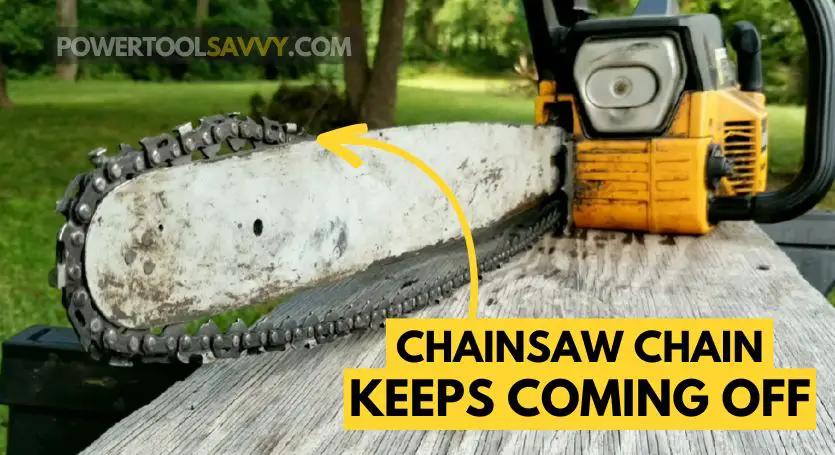
(Learn More: Why Does My Chain Keeps Coming Off the Bar?)
And here’s the thing: 👇
Using a different gauge than what is recommended could often lead to problems like chain stretch, jumping off the bar, and even breaking.
So if you don’t know what you’re doing, I’d strongly recommend sticking with the ORIGINAL gauge of your saw and bar.
Why is Chainsaw Chain Gauge So IMPORTANT?
The chain gauge is an important specification to consider when selecting a chainsaw chain. Because it determines whether the chain will fit your guide bar or not.
And as I’ve already mentioned – 👇
Using a chain with an incorrect gauge can lead to poor cutting performance, increased wear and tear on both the chain and guide bar, and can be DANGEROUS!⚠️
A chain that’s too thick for your bar won’t fit your bar, while a too thin chain won’t stay in place and may jump off the bar, snap, or break during use.
That’s why you need to know the gauge of your chain and make sure it’s compatible with your bar and saw!
What's the Most COMMON Chainsaw Chain Gauge?
The most common chainsaw chain gauge is 0.050″. This gauge size is versatile and can handle a wide range of cutting applications, making it popular among chainsaw nerds.
You’ll often find this gauge size on mid-range homeowner chainsaws, and some light-duty commercial saws as well!
Half of my saws have 3/8″ pitch and 0.050″ gauge chains. This combination works really well for all my cutting needs and I haven’t had any issues with it so far.
And it seems like I’m not alone! 🐸
Valek (an Arboristsite member) says, “We run 3/8 .050 on everything except the newly purchased Husqvarna 41…(Soon to be converted)“
Rmihalek (another Arboristsite member) says, “I run either 0.050″ or 0.058″ on my bigger saws and 0.043″ on the top handle saw and they all work great.” (Source)
But hey, I wouldn’t suggest changing to a different gauge just because everyone else is using it or because it’s the new HOT thing.
Pick the gauge that matches your saw’s requirement, not what’s trending!
And keep this in mind – Chainsaw chains are not universal. If a chain fits perfectly on one saw, it won’t necessarily fit another (regardless of the brand or model!)
So, pay attention to your saw’s chain gauge and make sure you get the RIGHT one!
GoodBye Words!
Well, that’s all there is to it!
I tried my level BEST to explain the concept of chainsaw chain gauge, how you can measure it, and why it’s so important.
I hope this was helpful and you’ll now be able to pick the right chain for your saw!
If you’ve got any more questions or need any help in the future, don’t hesitate to swing on by again!
Take care, and keep on choppin’ that wood like a PRO! 😎
Peace out! ✌️

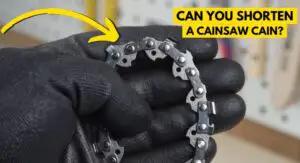

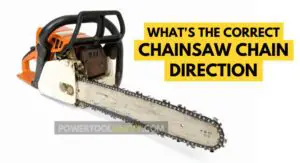
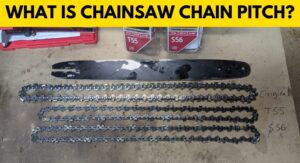

Pingback: 8 Symptoms of Worn Chainsaw Bar (Don't MISS This!)
Pingback: What is Chainsaw Chain Pitch? (Everything You Need to Know!)
Pingback: Are Chainsaw Chains Universal? (Spoiler: NO, Here's Why)
Pingback: How to Measure a Chainsaw Bar Length? (3 EASY Steps!)
Pingback: Chainsaw Bar Length VS CC Chart (Last Updated: June, 2023)
Pingback: Can I Put a Smaller Bar on My Chainsaw? (If YES, How Small?)
Pingback: When to Replace a Chainsaw Chain? (5 SURE Signs!)
Pingback: Chainsaw Chain Won't Tighten? Here's How You FIX It!
Pingback: Chainsaw Chain Keeps Coming Loose? 5 EASY Fixes!